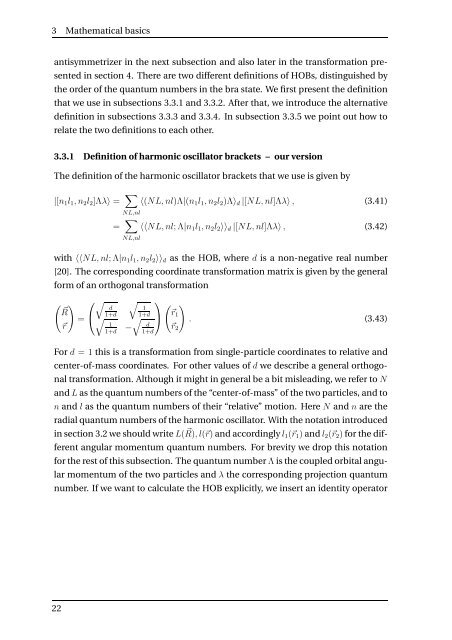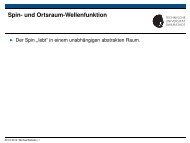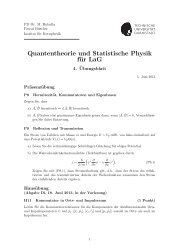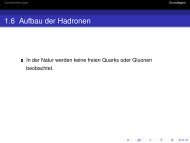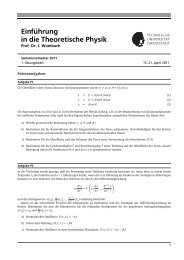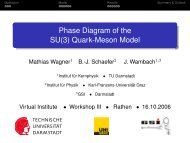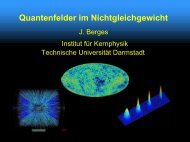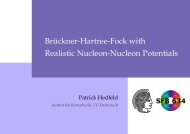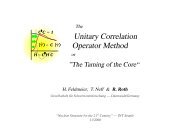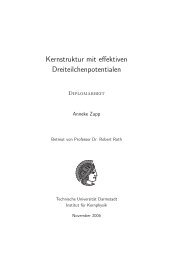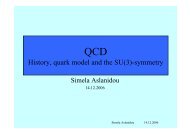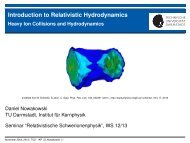Consistent chiral three-nucleon interactions in ... - Theory Center
Consistent chiral three-nucleon interactions in ... - Theory Center
Consistent chiral three-nucleon interactions in ... - Theory Center
Create successful ePaper yourself
Turn your PDF publications into a flip-book with our unique Google optimized e-Paper software.
3 Mathematical basics<br />
antisymmetrizer <strong>in</strong> the next subsection and also later <strong>in</strong> the transformation pre-<br />
sented <strong>in</strong> section 4. There are two different def<strong>in</strong>itions of HOBs, dist<strong>in</strong>guished by<br />
the order of the quantum numbers <strong>in</strong> the bra state. We first present the def<strong>in</strong>ition<br />
that we use <strong>in</strong> subsections 3.3.1 and 3.3.2. After that, we <strong>in</strong>troduce the alternative<br />
def<strong>in</strong>ition <strong>in</strong> subsections 3.3.3 and 3.3.4. In subsection 3.3.5 we po<strong>in</strong>t out how to<br />
relate the two def<strong>in</strong>itions to each other.<br />
3.3.1 Def<strong>in</strong>ition of harmonic oscillator brackets – our version<br />
The def<strong>in</strong>ition of the harmonic oscillator brackets that we use is given by<br />
|[n1l1, n2l2]Λλ〉 = <br />
〈(NL, nl)Λ|(n1l1, n2l2)Λ〉d |[NL, nl]Λλ〉 , (3.41)<br />
NL,nl<br />
= <br />
〈〈NL, nl; Λ|n1l1, n2l2〉〉d |[NL, nl]Λλ〉 , (3.42)<br />
NL,nl<br />
with 〈〈NL, nl; Λ|n1l1, n2l2〉〉d as the HOB, where d is a non-negative real number<br />
[20]. The correspond<strong>in</strong>g coord<strong>in</strong>ate transformation matrix is given by the general<br />
form of an orthogonal transformation<br />
d<br />
⎛<br />
R 1+d<br />
= ⎝<br />
r 1<br />
1+d −<br />
<br />
1<br />
1+d <br />
d<br />
1+d<br />
⎞ <br />
⎠<br />
r1<br />
r2<br />
. (3.43)<br />
For d = 1 this is a transformation from s<strong>in</strong>gle-particle coord<strong>in</strong>ates to relative and<br />
center-of-mass coord<strong>in</strong>ates. For other values of d we describe a general orthogo-<br />
nal transformation. Although it might <strong>in</strong> general be a bit mislead<strong>in</strong>g, we refer to N<br />
and L as the quantum numbers of the “center-of-mass” of the two particles, and to<br />
n and l as the quantum numbers of their “relative” motion. Here N and n are the<br />
radial quantum numbers of the harmonic oscillator. With the notation <strong>in</strong>troduced<br />
<strong>in</strong> section 3.2 we should write L( R), l(r) and accord<strong>in</strong>gly l1(r1) and l2(r2) for the dif-<br />
ferent angular momentum quantum numbers. For brevity we drop this notation<br />
for the rest of this subsection. The quantum number Λ is the coupled orbital angu-<br />
lar momentum of the two particles and λ the correspond<strong>in</strong>g projection quantum<br />
number. If we want to calculate the HOB explicitly, we <strong>in</strong>sert an identity operator<br />
22


